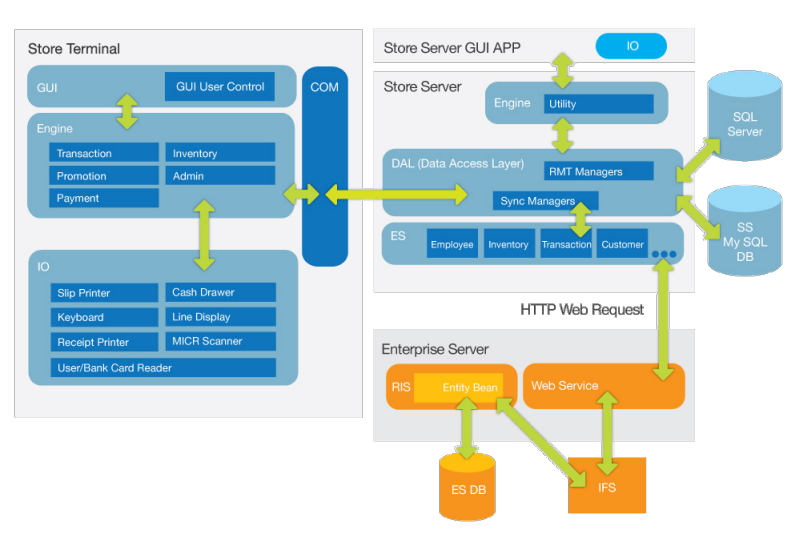This section applies to Retailarc Enterprise.
This diagram shows the technologies used within each of the components of Retailarc Enterprise and how they communicate between each other.

Store Terminal
The Store Terminal is built in .NET as a standalone application for speed and usability. The POS application uses the .NET Remote Client to communicate with the Store Server. There is no local storage at the POS terminal. All information is stored inside the Store Server database. Since the POS is standalone, it allows integration with peripherals such as cash drawers, biometric scanners, printers, card readers, and PIN pads at the local machine.
Store Server
The Store Server is also built in .NET to allow tight integration with the POS. It may reside on the same physical machine as one of the Store Terminals. The Store Server uses .NET Remote Host to allow the POS to send business operations, and a MySQL database for temporary data storage. The information in the database is synchronized with the enterprise server database on a regular basis.
The Store Server uses.NET socket calls to communicate with the POS application on the Store Terminals via the in-store network, and web service with SOAP protocol over either HTTP or HTTPS to communicate with the Enterprise Server over the external network. (If a VPN between the store and head office locations is available, then HTTP is sufficient. Otherwise HTTPS is recommended.)
Enterprise Server
The Enterprise Server consists of a number of components, including:
Web Service
The Web Service end point interfaces to external components such as the Store Server using the SOAP message protocol. Both HTTP and HTTPS are supported as the transport protocol. The web services call the session façade in the EJB tier to perform business functions. Entity Beans are directly mapped to individual entities inside the enterprise database. These are used by the business logic tier to insert or update the data.
RIS
The Retail Information Server (RIS) is the web application that enables authorized users to perform back office operations, including user administration, system configuration, and report generation. Some location operations are also carried out using RIS, such as store-to-store stock transfers and requests for products. Individual functions of RIS can be assigned to defined staff roles, which are also managed by RIS. Since RIS is accessible from anywhere, HTTPS is recommended.
IFS
The Information Forwarding Service (IFS) executes timed operations such as roll-over, during which the IFS refreshes all cached information. Web service calls are redirected to IFS using socket calls. IFS then connects to the EJB using RMI/IIOP if necessary. The EJB then connects to the enterprise data store using JDBC which is managed by the application server.
